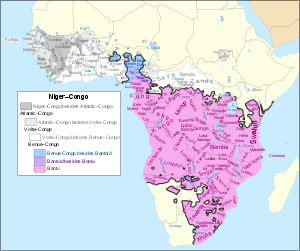Benue–Congo languages
| Benue–Congo | |
|---|---|
| East Benue–Congo | |
| Geographic distribution | Africa, from Nigeria east and south |
| Linguistic classification |
|
| Subdivisions |
|
| Glottolog | benu1247[1] |
|
The Benue–Congo languages shown within the Niger–Congo language family. Non-Benue–Congo languages are greyscale. | |
Benue–Congo (sometimes called East Benue–Congo) is a major subdivision of the Niger–Congo language family which covers most of Sub-Saharan Africa. It consists of two main branches: Central Nigerian (or Platoid), spoken in Nigeria and Cameroon, and Bantoid–Cross, also spoken in Nigeria and Cameroon but including the Bantu languages (through Southern Bantoid) spoken across most of Sub-Saharan Africa.
Central Nigerian (Platoid) links the Plateau, Jukunoid and Kainji languages of Nigeria, and Bantoid–Cross links the Bantoid and Cross River languages of Nigeria and Cameroon (as well as most of Sub-Saharan Africa, through Bantu). Bantoid is a collective term for a few subfamilies no longer seen as forming a valid branch; one of those subfamilies, Southern Bantoid, is still considered valid. Southern Bantoid includes the Bantu languages, which are spoken across most of Sub-Saharan Africa. This makes Benue–Congo one of the largest subdivisions of the Niger–Congo language family, both in number of languages, of which Ethnologue counts 976 (2017), and in speakers, numbering perhaps 350 million. Benue–Congo also includes a few minor isolates in the Nigeria–Cameroon region, but their exact relationship is uncertain.
The neighbouring Volta–Niger branch of Nigeria and Benin is sometimes called West Benue–Congo, but it does not form a united branch with Benue–Congo.
When Benue–Congo was first proposed by Joseph Greenberg (1963) it included the Volta–Niger languages (as West Benue–Congo); the boundary with those languages and with Kwa has been repeatedly debated. Blench (2012) states that if Benue–Congo is taken to be "the noun-class languages east and north of the Niger", it is likely to be a valid group, though no demonstration of this has been made in print.[2]
The branches of the Benue–Congo family are thought to be as follows:
- Bantoid–Cross
- Central Nigerian, also known as Platoid
Ukaan is also related to Benue–Congo; Roger Blench suspects it may be either the most divergent (East) Benue–Congo language or the closest relative to Benue–Congo.
Fali of Baissa and Tita are also Benue–Congo but are otherwise unclassified.
References
- ↑ Hammarström, Harald; Forkel, Robert; Haspelmath, Martin; Bank, Sebastian, eds. (2016). "Benue–Congo". Glottolog 2.7. Jena: Max Planck Institute for the Science of Human History.
- ↑ Roger Blench, Niger-Congo: an alternative view
- Wolf, Paul Polydoor de (1971) The Noun Class System of Proto-Benue–Congo (Thesis, Leiden University). The Hague/Paris: Mouton.
- Williamson, Kay (1989) 'Benue–Congo Overview', pp. 248–274 in Bendor-Samuel, John & Rhonda L. Hartell (eds.) The Niger–Congo Languages – A classification and description of Africa's largest language family. Lanham, Maryland: University Press of America.

